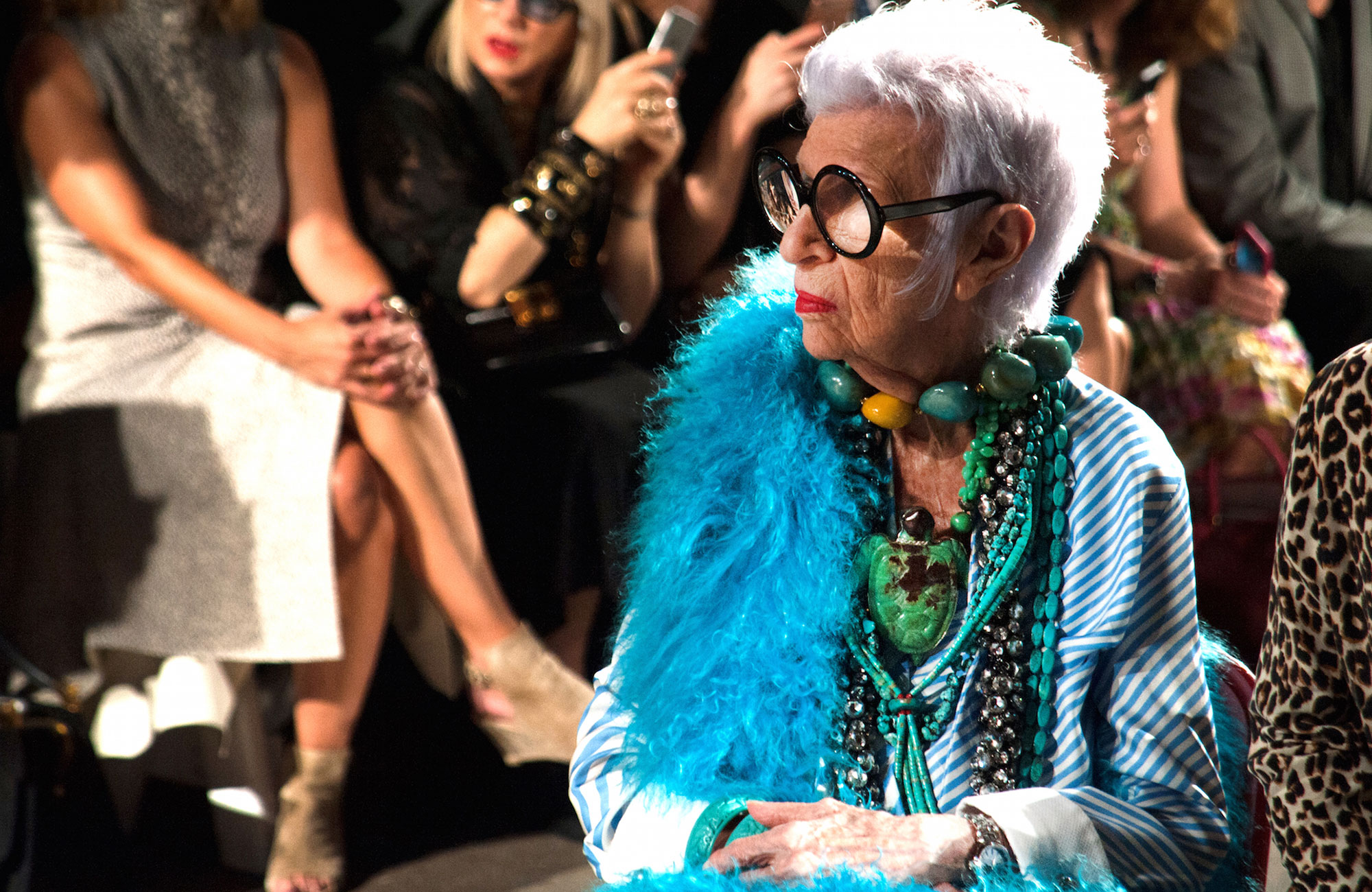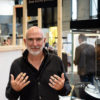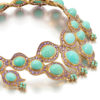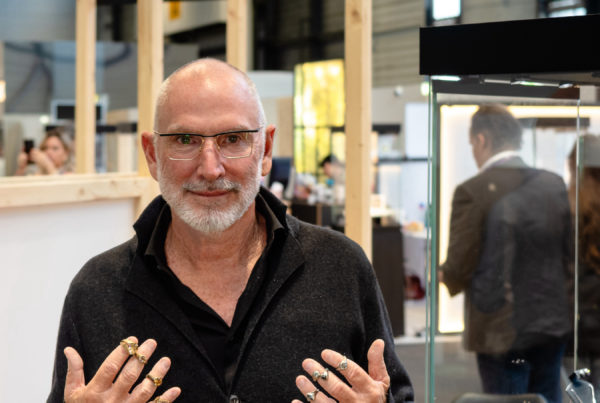Iris Apfel, geriatric starlet
ARCHIVES. This fashion icon died on 1 March 2024 at the age of 102. She had never given so many interviews as she did in her old age. A brand ambassador, collector and interior designer, she had a thousand lives and only one husband, with whom she restored the White House under the reign of nine presidents. Her idiosyncratic style is an endless source of inspiration. I met her in December 2016: she was 95. This interview was published on 3 December 2016 – Isabelle Cerboneschi, New York.

There are a few rare personalities in the world of design and fashion whose allure, a detail, is sufficient to identify them. A catogan, dark glasses and a high collar? Karl Lagerfeld. A triangular face and a frothy patch of red hair? Sonia Rykiel. A pair of enormous round glasses, a red mouth and a bob of purple hair: Iris Apfel.
Since the Metropolitan Museum of Art in New York dedicated an exhibition to her in September 2005 entitled Oiseau rare, curated by Harold Koda (head of the Costume Institute until 2015, ed. note), Iris Apfel has become a world-adulateded fashion icon.
He wanted me to put together an exhibition of accessories, but presenting them out of context didn’t make sense,” she says. He asked me to present some of my outfits and accessorise them in my own way. While she was mainly known to a certain American public, by revealing the secrets of her dressing room, she saw the number of her admirers multiply.
Iris Apfel was born in Queens, of which she kept her accent, of a father who sold mirrors and a mother who was a shop assistant. Fame fell on her by accident, she says, like all the important things in her life. Her intuitions led her to work as an editor for Woman’s Wear Daily and, in 1950, to set up a precious fabrics factory with her husband Carl: Old World Weavers. Carl was the love of her life: she married him in 1948 and lived a happy marriage of sixty-seven years with him, until he passed away in August 2015 at the age of 100.
Creating designs and re-editing antique fabrics, the Apfels quickly became the darling of American high society. Together, they were involved in the restoration of the White House under the reign of nine presidents. Their clientele included the most flamboyant personalities of the era: Greta Garbo, the wealthy heiress Marjorie Merriweather Post and Estée Lauder, to name but a few. The Apfels sold their company in 1992 to Stark Carpet, which continues to publish some of their fabrics.

This frantic clothes collector has developed an idiosyncratic style, combining haute couture and flea-market finds, ecclesiastical garments and Dolce & Gabbana lizard trousers, all accentuated by jewellery of exaggerated proportions, including her famous bracelets stacked on her wrists and forearms, in the style of writer Nancy Cunard. A style to match her humour. When Iris Apfel tells her story, her jewels clash and accompany her speech in off-beat fashion.
This 95-year-old geriatric starlet, as she calls herself, has never given so many interviews or lent her image to so many brands (Citroën, TAG Heuer) as she has since she entered her old age. Last September, she was seated in the front row of the Monse fashion show in New York wearing on her wrist the first model in a new collection of watches launched on the American market by TAG Heuer: the Link Ladies Collection. This fashion icon had agreed to push aside her tinkling bracelets in order to leave a portion of her wrist free to accommodate the new watch.
INTERVIEW
You say you’re a 95-year-old geriatric starlet, you’re an ambassador for many brands, what does your image say to people?
Iris Apfel :Ask them! I guess I’m sending them back an image of authenticity. And that also implies a certain sense of style, originality, creativity and longevity (laughs). People often tell me that I’m not fake and they know that if I associate my name with something, it’s because I’m sincere.
Is that why you associated it with TAG Heuer?
I love their history, I like the quality and I’m very flattered to be associated with them. I find the design of their new watch very beautiful. It has a large dial and I like anything big: it’s much easier to see.

I met you backstage at Dries Van Noten’s autumn-winter 2016-2017 show in Paris in March 2016. He told me that you were a source of inspiration for him. It’s great to continue to inspire designers!
I was so excited about the idea of this show! Someone had asked Dries to make a list of ten things he couldn’t live without, and my name was on that list! I’d met him a few years ago at a party in New York. He had come to open a boutique at Bergdorf Goodman and I had been invited to the event. I wondered why, because I didn’t know him. He came up to me, introduced himself and explained that he was offered to invite absolutely whom he wished, and he replied that there was only one person he wanted to meet, and that was me. I just love him! He’s so genuine, original, creative, kind and cute. He’s not a phoney designer like a lot of people, he has a lot of integrity and he likes beautiful fabrics. I loved his show. He makes clothes that people can wear, unlike some crazy people.
He makes his own fabrics. You must be sensitive to that fact, right?
He loves fabrics and putting unusual things together. He told me that I inspire him, that he keeps my book in his workshop and that sometimes when he can’t get a designer to understand him, he shows him one of my photos. I was delighted (laughs).
One of your style lessons can be summed up in one sentence: More is more, less is a bore. Do you think more people should apply it?
It applies to me personally. You have to know how to dose ‘more’, otherwise you can quickly look like a Christmas tree! Some people have a minimalist style and that suits them very well. I’m not telling anyone what to wear. I think everyone needs to be aware of this for themselves. That’s where the problem lies: so many people don’t take the time to get to know themselves and what they can wear, what their comfort zone is. They blindly follow what others are doing. It’s easier, but it’s not creative or very interesting. They all look the same. I’ve noticed that over the last few winters in New York, all the girls have looked the same from the back. They had long straight hair, either loose or in a ponytail, leather bomber jackets, black tights, black thigh-high boots. You could tell it was the same person. Why, when there’s such a choice of gorgeous pieces, would you want to look like everyone else? I don’t understand it.

You used to be a decorator: did the fabrics used to decorate interiors influence the way you dressed?
I think it’s part of a whole: you do both things with the same sensibility. When you’re a designer, you decorate your home and when you dress, you decorate yourself. It’s all the same.
Do you feel you’ve invented yourself through your clothes and accessories?
I have invented myself, yes, but I haven’t done it consciously. I never do anything consciously, in fact, it’s all visceral. I can explain things intellectually, but I do them intuitively. People say that I claim to be a rebel. But that’s not true. I simply do what I want. Nobody has to tell me what to do, just as I don’t presume to tell anyone what he or she should do. Everyone has to know what is comfortable for them.
What was it like when you and your husband Carl decorated the White House?
You don’t decorate the White House, you restore it. It’s a real historical restoration: everything has to be made exactly as it was, as close as possible to what was. Even if it’s the ugliest thing in the world, it’s absolutely impossible to change. You can’t decide to change that ugly colour to blue, for example, even if the result would be beautiful. So we provided the fabrics, we made them as close to the models as possible. We were given the originals.
If you had the chance to turn the hands of your watch backwards, what moment would you choose to relive?
If you suggested such a thing, I’d tell you to go away! I’ve chosen to live in the here and now. I wish to move forward, I don’t want to go backwards.

Why do you like vintage clothes? Don’t you think there’s enough creativity in today’s designers and creators?
Vintage clothes have more integrity. And old clothes make me look younger (laughs). Clothes from the 1950s to the 1990s were much better made. There was more originality, it was the golden age of fashion in the USA, we had wonderful designers, the quality of the work was superb. Nowadays, clothes are very poorly made, they cost more, but they’re badly assembled. I think fashion is in a hole and lacks creativity. Fortunately, I’ve kept a lot of my clothes and I can go shopping in my wardrobe!
We live in a world where young people are in the spotlight – all we talk about are Millennials and how to appeal to them – while older people are hidden away, sidelined. How can we change this?
I hope to be a living example of what can change! People need to realise that at the age of 95, there’s no need to curl up and wait to die: there’s still so much to do! You just need to motivate yourself. When you reach a certain age, when you get up, as my mother used to say, everything you have in your body hurts. But if you stay at home, all you do is think about it. Unless you’ve got pneumonia or a broken hip, you’ve got to get out of bed and start doing something! I don’t think about my pain when I’m working. It’s when I stop that it hurts again. You always have to keep busy, keep your mind occupied. Nothing is free, everything has a price.













